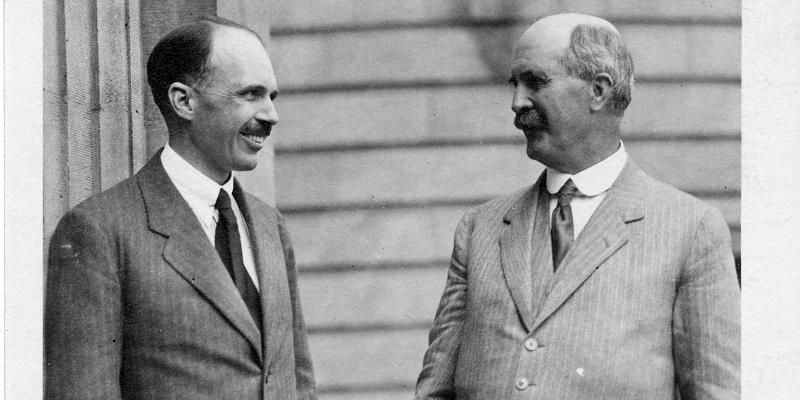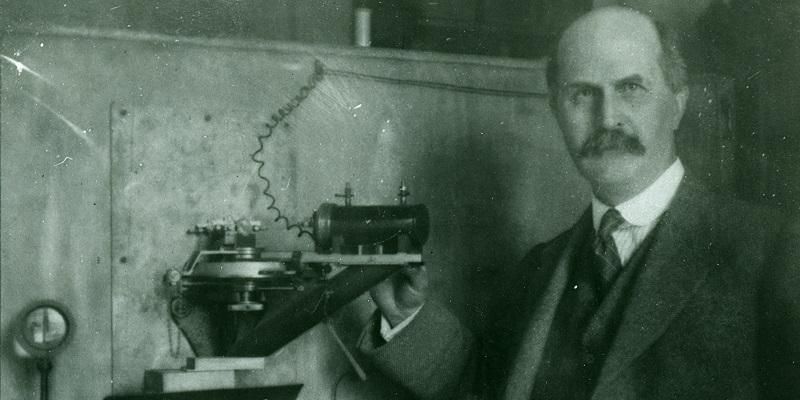
An exhibition about a father and son team who made one of the most significant scientific discoveries of the 20th century opens today at the University.
Sir William Henry Bragg, who was Cavendish Professor of Physics at Leeds, and his son Lawrence, developed a technique for studying the structure of a crystalline material.
The work, which resulted in the scientists being jointly awarded the Nobel Prize for Physics in 1915, had a profound impact on science. It led to the development of a new branch of physics called X-ray crystallography that enabled scientists to calculate the position of atoms in a crystal.
From that pioneering work in the early 1900s, X-ray crystallography has been used as a tool for scientists in a range of applications - from investigating DNA, unravelling the structure of proteins to the development of new drugs and vaccines.
Together they provided the springboard for scientific discoveries that would eventually reveal the secrets of nature
The exhibition – Shaping the Course of Modern Science: William Henry Bragg and his Legacy at the University of Leeds – opens at The Stanley & Audrey Burton Gallery, in the Parkinson Building, today and runs until 5 March 2022. Entry is free and open to all.
It is part of a season of events called Inspired by Bragg, which celebrates the work and achievements of the scientists. It runs until next summer and culminates in the formal opening of the new home for the School of Computing and School of Astronomy and Physics, in the Sir William Henry Bragg building.
The building is already being used by students and researchers.
Over the coming months there will be a stage performance, specially composed music and a public lecture to mark the scientific legacy of the Braggs.
The exhibition
The exhibition contains the original notebooks that the Braggs used to record the results of their experiments in 1913. These unique books from the University's Special Collections reveal the handwritten discoveries which led the scientists to formulate what is known as Bragg’s equation,
Also on display is the original X-ray spectrometer developed by William Henry Bragg to investigate the structure of crystals, on loan from the Royal Institution.

Visitors will also be able to see the Nobel Prize Medal awarded to the Braggs for - in the words of the official citation – "their services in the analysis of crystal structure by means of X-rays". The medal is kindly on loan from the Bragg family. A copy of the medal has been made which will feature in a permanent display about the Braggs, which will be located in the William Henry Bragg building.
Dr Stella Butler, curator of the exhibition and former University Librarian and Keeper of the Brotherton Collection, said: “William Henry Bragg and his son Lawrence formed a fantastic scientific partnership. The father brought amazing experimental skill, the son theoretical genius. Together they provided the springboard for scientific discoveries that would eventually reveal the secrets of nature.”
The Braggs and Leeds
Sir William Henry Bragg arrived at Leeds in 1909. He was born in the Lake District but had spent time in Australia where he married and had a family. Lawrence was 19 when his father brought the family to Britain, and he went to study at the University of Cambridge.
Father and son collaborated on their research. They were interested in the work of a German scientist called Max von Laue who had discovered that a beam of X-rays would diffract or scatter if it passed through a crystal structure.
Through experimentation, they developed Bragg’s Law - a mathematical equation which explained the way the X-rays would scatter. With that equation, they could determine the position of atoms in the crystal structure.
At Leeds, William Henry Bragg developed a scientific instrument, an X-ray spectrometer, to measure the way the X-rays scattered. It was used to determine the structure of rock salt, sodium chloride and diamond.
The Braggs were both keen amateur artists who would create watercolours and pencil sketches, and some of their artwork is on display in the exhibition. Dr Butler believes the ability of the Braggs to think and create in 3-D, so evident in their artwork, was crucial in enabling them to unravel the secrets of crystallography.
She said: “The two scientists had to interpret a lot of information about the way the X-rays were scattering, about the angles and distances involved and how they could use that information to infer the structure of atoms in a crystal.
“What enabled this, I think, was their ability to think and visualise in 3-D.”
Legacy of the Braggs
The exhibition also shows the long-term impact of X-ray crystallography on science.
The Bragg equation has been in continual use since it was first published in the early 1900s and has helped leading scientists over the last ten decades to uncover the secrets of life and to inform life changing developments of new treatments and vaccines, such as the COVID-19 vaccine - impacting the lives of everyone across the world.
Exhibition Catalogue
An exhibition catalogue will be available. An impressive range of academic voices delve deeper into Bragg’s achievements and enduring legacy, discussing his Nobel Prize-winning research at Leeds, his influence on subsequent pioneering scientists and the future of X-ray crystallography. The essays provide further context to the equipment, papers and images on display and demonstrate how the Braggs’ work has shaped modern science.
Further information
Top image: Lawrence Bragg and William Henry Bragg at the British Assoc, Toronto, 1924. Smithsonian Institution Archives, Accession 90-105, Science Service Records, Image No. SIA2007-0340
For more information, contact David Lewis in the Press Office at the University of Leeds by email on d.lewis@leeds.ac.uk.